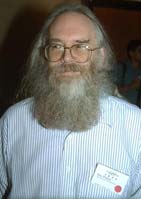1984
Domain Name System
After some quarrelling and arguing within the internet community in 1984, it happened that the Domain Name System (DNS) was introduced. The development and introduction of DNS mainly had one reason: as the size of the network reached about 2.000 hosts, everything started to burst at the seams.

Jon Postel

Instead of having one big mainframe with 20000 users on it, the network was suddenly flooded with single machines. Every host had a username and for some reason everybody wanted to be named “Frodo”. Sorting all Frodos on the internet would have been similar to sorting everybody in Berlin named Schulz. Now the location can tell much about who is who on the internet. For many years this differentiation has been one of the trickiest problems on the internet.
The core of the DNS-team, which was keen on solving this problem, consisted of Jon Postel, Paul Mockapetris from ISI and Craig Partridge from BBN. With the use of DNS every address could be structured hierarchically. But which hierarchy level should come first? Postel and other members of the internet community finally decided in favour of addressing from general to particular. The first seven top-level domains were: .edu, .com, .gov, .mil, .net, .org and .int.
The core of the DNS-team, which was keen on solving this problem, consisted of Jon Postel, Paul Mockapetris from ISI and Craig Partridge from BBN. With the use of DNS every address could be structured hierarchically. But which hierarchy level should come first? Postel and other members of the internet community finally decided in favour of addressing from general to particular. The first seven top-level domains were: .edu, .com, .gov, .mil, .net, .org and .int.
1984
Net
Facts
Facts


The number of hosts on the ARPANET exceeds 1.000.
1984
Other
Events
Events
The agreement between Great Britain and China to return Hong Kong to China in 1997 is signed.
Apple releases the first Macintosh computer.
IBM releases the Megabit RAM-Chip and the PC-AT.
The properties of “genetic fingerprinting“ are identified.


